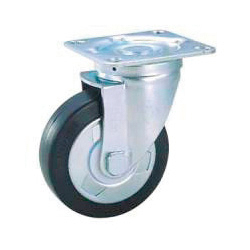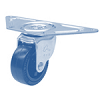(!)NOTE : Windows 7 users won’t be able to use some latest features of eCatalog/WOS since Microsoft is ending support for Windows 7 on 14 Jan, 2020. Please upgrade your system for uninterrupted services.
- Notice of End of Sales for Economy Series Pneumatic Equipment Category. More information.
Casters
Brand |
|
|---|---|
| CAD |
|
| Days to Ship |
|
1 items
- Sort By
-
You can add up to 6 items per a category to the compare list.

General-Purpose Caster, STC Series, Swivel
NANSIN
A highly compatible, industry standard, swivel caster.
[Features]
·This product has a double-ball structure in the swivel section, which maintains stable swivel performance for a long time even under load in the limiting range.
·You can choose from a wide range of products, from household products to commercial equipment, depending on your application.
·The STC and SKC types have the same mounting height and can be used together with both the swivel and fixed types.
·The metal fittings has a bright chromate plating finish.
[Applications]
·With a wide range of wheel diameters and wheel materials, it can be widely used from commercial equipment to household products.- CAD :
- 2D
Mounting Height H(mm) Type Caster Type Load Range(daN) Wheel Dia. D(Ø) Stopper (Detail) Wheel Material Fitting Material Mounting Hole Pitch, Short Length Direction W1(mm) Mounting Hole Pitch, Long Length Direction L1(mm) Thread Dia. Wheel Characteristics Mounting Hole Pitch Circular Diameter(mm) Mounting Hole Type 165 ~ 190 Caster Plate Type Swivel 140.01~220.00 125 ~ 150 Not Provided Synthetic Rubber / Nylon / Urethane Steel 75(80) 75(80) - Oil Resistance / Not Provided - Slotted Hole From: ₹ 1,670.09 Days to Ship: 8 Day(s) or more  8 Day(s) or more
8 Day(s) or more
| Brand |
|---|
| Product Series |
| CAD |
| From |
| Days to Ship |
| Mounting Height H(mm) |
| Type |
| Caster Type |
| Load Range(daN) |
| Wheel Dia. D(Ø) |
| Stopper (Detail) |
| Wheel Material |
| Fitting Material |
| Mounting Hole Pitch, Short Length Direction W1(mm) |
| Mounting Hole Pitch, Long Length Direction L1(mm) |
| Thread Dia. |
| Wheel Characteristics |
| Mounting Hole Pitch Circular Diameter(mm) |
| Mounting Hole Type |
You can add up to 6 items per a category to the compare list. | |
| Brand | NANSIN |
| Product Series | |
| CAD |
|
| From | ₹ 1,670.09 |
| Days to Ship | 8 Day(s) or more |
| Mounting Height H(mm) | 165 ~ 190 |
| Type | Caster |
| Caster Type | Plate Type Swivel |
| Load Range(daN) | 140.01~220.00 |
| Wheel Dia. D(Ø) | 125 ~ 150 |
| Stopper (Detail) | Not Provided |
| Wheel Material | Synthetic Rubber / Nylon / Urethane |
| Fitting Material | Steel |
| Mounting Hole Pitch, Short Length Direction W1(mm) | 75(80) |
| Mounting Hole Pitch, Long Length Direction L1(mm) | 75(80) |
| Thread Dia. | - |
| Wheel Characteristics | Oil Resistance / Not Provided |
| Mounting Hole Pitch Circular Diameter(mm) | - |
| Mounting Hole Type | Slotted Hole |
Loading...
Configure
Specification/Dimensions
-
Mounting Height H(mm)
- 12.5
- 21
- 23.5
- 30
- 32
- 34
- 35
- 36
- 39
- 42
- 42.5
- 43
- 43.5
- 44
- 44.5
- 45
- 46
- 46.5
- 47
- 48
- 49
- 50
- 50.5
- 51
- 51.5
- 52
- 53
- 54
- 54.5
- 55
- 56
- 57
- 57.5
- 58
- 58.5
- 59
- 59.5
- 60
- 61
- 62
- 63
- 63.5
- 64
- 65
- 65.5
- 66
- 67
- 68
- 68.5
- 69
- 70
- 70.5
- 71
- 72
- 72.5
- 73
- 74
- 74.5
- 75
- 76
- 77
- 77.5
- 78
- 79
- 79.5
- 80
- 81
- 82
- 83
- 84
- 84.5
- 85
- 86
- 87
- 87~75
- 87.5
- 88
- 89
- 89~77
- 90
- 91
- 92
- 92.5
- 93
- 94
- 95
- 95.5
- 96
- 96.5
- 97
- 98
- 99
- 99.5
- 100
- 101
- 102
- 102.3
- 102.5
- 103
- 104
- 105
- 105.5
- 105.8
- 106
- 107
- 108
- 109
- 110
- 111.5
- 112~100
- 112.5
- 113
- 114
- 114~102
- 115
- 117
- 117.5
- 118
- 119
- 120
- 121
- 122
- 123
- 124
- 124.5
- 125
- 126
- 126.4
- 126.5
- 127
- 128
- 129
- 129.3
- 130
- 130.5
- 132
- 132.5
- 133
- 133.5
- 134
- 135
- 136
- 137
- 137~125
- 138
- 139
- 139~127
- 140
- 141
- 142
- 143
- 144
- 145
- 148
- 150
- 151
- 152
- 152.4
- 152.5
- 153
- 153~145
- 153.5
- 155
- 155.5
- 156
- 157
- 158
- 159
- 160
- 161
- 162
- 163
- 165
- 165(142)
- 166
- 168
- 168.5
- 170
- 171~148
- 171~154
- 171~158
- 173
- 175
- 176
- 177
- 178
- 178.5
- 179
- 180
- 182
- 183
- 184
- 184.5
- 185
- 185 to 205
- 185.5
- 186(161)
- 186.6
- 187
- 188
- 190
- 190.5
- 191
- 192
- 193~167
- 193~173
- 193~177
- 193 to 183
- 194
- 195
- 196
- 196.6
- 198
- 199.5
- 200
- 202
- 203
- 205
- 210
- 210~198
- 213
- 217
- 217.5~337.5
- 220
- 225
- 230
- 230 to 250
- 235
- 237
- 239.5
- 240
- 241
- 245
- 246 to 236
- 247.3
- 250
- 250~235
- 251
- 255
- 256
- 257
- 260
- 260~250
- 267
- 270
- 272~392
- 275
- 275~255
- 275~260
- 285
- 287
- 289
- 290
- 292
- 293
- 300
- 302
- 304
- 305
- 306
- 308
- 312
- 315
- 317
- 320
- 330
- 350
- 355
- 360
- 365
- 367
- 370
- 371
- 374
- 375
- 378.5
- 394
-
Type
- Caster
-
Caster Type
-
Load Range(daN)
- ~35.00
- 35.01~80.00
- 80.01~140.00
- 140.01~220.00
- 220.01~320.00
- 320.01~485.00
- 485.01~750.00
- 750.01~
-
Wheel Dia. D(Ø)
-
Stopper (Detail)
- Not Provided
- With Rotation Stopper
- With Swivel Stopper
- With Double Stopper (Rotation + Swivel)
-
Wheel Material
- Synthetic Rubber
- Nylon
- Urethane
- Polyurethane
- Phenol
- Engineering Plastics
- Steel
- Others
- Stainless Steel
- Rubber
- Elastomer
-
Fitting Material
- Steel
- Stainless Steel
- Others
- Aluminum
- Steel
- Zinc
-
Mounting Hole Pitch, Short Length Direction W1(mm)
-
Mounting Hole Pitch, Long Length Direction L1(mm)
-
Thread Dia.
-
Wheel Characteristics
-
Mounting Hole Pitch Circular Diameter(mm)
-
Mounting Hole Type
Related Categories to Casters
FAQ Casters
- Question: How do you choose the right castor wheels for a particular application?
- Answer: Essential points to consider before choosing the right casters consist ofEssential points to consider before choosing the right casters consist of
1. Load Capacity: Determine the maximum weight the castor wheels will need to support. It is crucial to choose wheels with a load capacity that not exceeds the specification to ensure safety and longevity.
2. Wheel Diameter: The size of the wheels affects maneuverability and stability. Larger wheels roll more easily over uneven surfaces and obstacles, but they may require more space. Smaller wheels may not perform as well on rough surfaces.
3. Wheel Material: Consider the type of floor or surface the wheels will encounter. Different materials are suitable for various applications. For example: Rubber, Polyurethane, Nylon, Steel and so on
4. Wheel Type: Depending on the application, you may choose from different wheel types, such as: Swivel wheels, Fixed wheels or other option like a foot brake system
5. Environment: Consider the operating environment and conditions. For example: Indoor or outdoor, rough surfaces, in a manufacturing environment like a electronic industrial
- Cleanroom or healthcare settings: Castor wheels for these environments need to meet specific cleanliness and hygiene standards.
6. Mounting Options: such as plate mount, stem mount, or bolt hole mount and so on - Question: What are some common materials used in the manufacturing of caster wheels?
- Answer: 1. Rubber: its high durability, shock absorption, and non-marking properties.
2. Polyurethane (PU): This caster’s material is often used in industrial settings where heavy loads or uneven surfaces are common.
3. Nylon: This caster’s material is commonly used in industrial and commercial applications. Nylon wheels are also non-marking and have good resistance to chemicals and solvents.
4. Cast iron: They are commonly used in industrial applications where high load capacities and durability are required. However, cast iron wheels can be noisy and are not suitable for delicate or smooth floor surfaces.However, cast iron wheels can be noisy and are not suitable for delicate or smooth floor surfaces.
5. Steel: Steel wheels also can withstand heavy loads. They are often used in industrial settings where extreme conditions, such as high temperatures or harsh environments.However, steel wheels can be noisy and are not suitable for delicate or smooth floor surfaces. - Question: What are the differences between chair casters and heavy-duty industrial wheels?
- Answer: Here are some key differences between chair casters and heavy-duty:
1. Load Capacity:
Chair casters: can support only the weight of the person
Heavy-duty: can support the weight of machinery and other equipment
2. Materials :
Chair casters made of lighter materials like nylon, rubber, or polyurethane, and so on.
Heavy-duty caster made of cast iron or steel, so it cannot carry a lot of loads
3. Floor Protection:
Chair casters are designed to be floor-friendly, with no any mark on the floor
Heavy-duty casters sometimes can make a mark on the floor - Question: What are some features of heavy-duty casters that make them suitable for industrial applications?
- Answer: Here are some features that make heavy-duty casters suitable for such environments:
1. Load Capacity: Heavy-duty casters are designed to support and transport substantial weight capacities. They have higher load ratings compared to standard casters
2. Robust Construction and wheel materials: Heavy-duty casters are built with durable and strong materials to withstand the rigors of industrial environments. Common materials used include steel, cast iron and stainless. Moreover, the wheel material for example Nylon, Polyethylene or reinforced polymers.
3. Large Wheel Diameter: Heavy-duty casters often feature larger wheel diameters, which provide several advantages. Larger wheels can roll more easily over uneven surfaces. They also distribute the load over a larger area
4. Bearing Type: Heavy-duty casters are often use ball bearings or precision tapered roller bearings are commonly used to handle heavy loads
5. Locking System: Many heavy-duty casters come with locking mechanisms to secure the wheels in place when needed. These brakes or locks prevent unintended movement and increase safety provide stability during loading, unloading, or stationary applications.
6. Shock Absorption: Some heavy-duty casters are designed with shock-absorbing features to minimize vibrations and impacts during transportation.


















How can we improve?
How can we improve?
Thank you for your time.
Your feedback is essential for our continuous improvement
Privacy Policy
Thank you for your cooperation.
Thank you for your time.
Your feedback is essential for our continuous improvement
Please use the inquiry form.
Privacy Policy